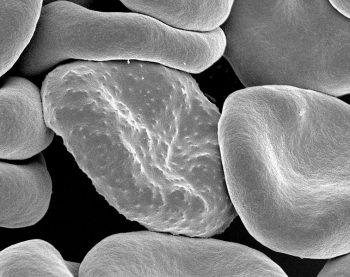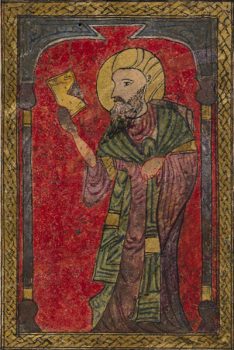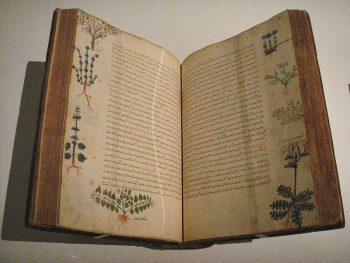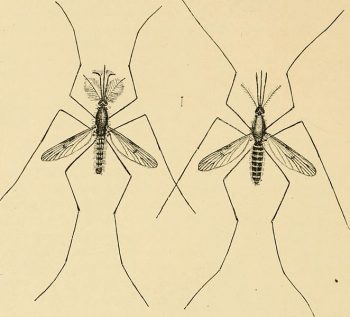“Roman Fever”: Did Malaria Bring Down the Roman Empire? Posted by Brittany Britanniae on Dec 7, 2016 in Roman culture, Uncategorized
A newly published study has just provided compelling genomic evidence in 2,000 year old human bones to show that malaria was, as many have guessed and speculated, present in Rome.

Electron micrograph of red blood cells infected with Plasmodium falciparum, the parasite that causes malaria in humans.
Courtesy of Wikimedia Commons.
For Latin-learners you could see the Medieval Latin roots behind the infamous disease: Malaria = mal + aria = “bad” + “air”. Although the disease picked up this name long after the Imperial period, the disease was known as the “Roman Fever” because of how frequently it spread through the Empire and how pervasive it was.

Portrait of Dioscorides from De Materia Medica. Courtesy of Wikimedia Commons.
One example of evidence that historians have used to theorize how pervasive malaria was is through the writings of Dioscorides. Dioscorides, a Greek physician who traveled with the Roman army, wrote the book De Materia Medica (“On Medical Material”) between the years 50 and 70 AD. This book discussed over 600 plants and their medicinal properties. Of the uses of these plants there was a particular reoccurring emphasis on plants that could help in “reducing the spleen” which was believed to alleviate “Roman Fever”.

Dioscorides De Materia Medica Byzantium 15th century. Courtesy of Wikimedia Commons.
The recent study was conducted on 58 skeletons that were buried in cemeteries that were from the Imperial period. These cemeteries were Isola Sacra (associated with Portus Romae, 1st–3rd century CE), Velia (1st–2nd century CE), and Vagnari (1st–4th century CE). Using DNA technology on the molars of these individual skeletons they found the lingering evidence in two of the individuals.
This discovery places malaria in Italy several centuries before previous investigations had reported. Italy’s terrain probably played a large role in the spread of the disease. Several areas would have been at-risk such as southern Italy, the island of Sardinia, the Pontine Marshes, the lower regions of coastal Etruria and the city of Rome along the Tiber River. These places would have had large amounts of stagnant water that would serve as homes and nurseries for disease-carrying mosquitoes.

Malaria Mosquitos, Anopheles quadrimaculatus. Adult male and female. Greatly enlarged. fever, and Culex ciliaris the parasitic Filarias which produce elephantiasis. Courtesy of Wikimedia Commons.
If you are familiar with Livy’s writings you might remember these marshes from the famous story of the Secessio plebis. After the Secessio plebis, a strike of the commoners for political rights, there was a famine throughout Rome. In order to supplement the food rations for other parts of the empire grain buyers were sent to the marshes to buy grain. However, they were refused this time. In this moment of weakness of famine and unbalanced goods th Volsci, an Italic tribe at odds with the Romans, planned to invade Rome. However, they were struck down by an epidemic. Although it is not confirmed, it was believed to have been malaria.
After another epidemic of malaria, about 60 years later, the people of the Pontine Marshes would concede and give grain to the rest of Rome. Again, we see how often malaria outbreaks might have occured in the empire and what these outbreaks did to the organization of the empire.
The theory that malaria’s presence in Ancient Rome was so influential that it may have contributed to the fall of the entire Empire is an old and popular theory. The effects of constant outbreaks of the disease must have thinned the population and weakened the control throughout the empire as well as caused disorganization and paranoia to spread. However, even after this new evidence, experts say not to forget other health factors such as lead poisoning, parasitic infections, venereal diseases, and insufficient nutrition. An epidemic of “Roman Fever” during the 5th century AD may have aggravated conditions within the Empire and helped send it toppling into ruin, but there were several other factors that played larger roles.
However, we have learned from this new study that malaria, now shown through the collection of this compelling evidence, had a very long and ancient history in the marshes of Rome. The modern struggle with malaria is still waging, all these centuries later, and so learning how the disease spread or affected populations in ancient times can help epidemiologists further study the behavior and history of this disease.
Sources:
Plasmodium falciparum malaria in 1st–2nd century CE southern Italy. Marciniak, Stephanie et al. Current Biology , Volume 26 , Issue 23 , R1220 – R1222
Sallares R (2002). “Malaria and Rome: a history of malaria in ancient Italy”. Oxford University Press

Build vocabulary, practice pronunciation, and more with Transparent Language Online. Available anytime, anywhere, on any device.
About the Author: Brittany Britanniae
Hello There! Please feel free to ask me anything about Latin Grammar, Syntax, or the Ancient World.




Comments:
Jesus christ:
Ohh yea, malaria…